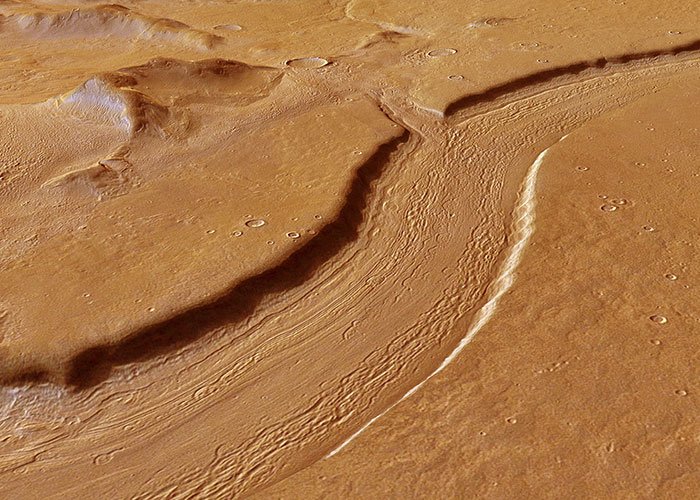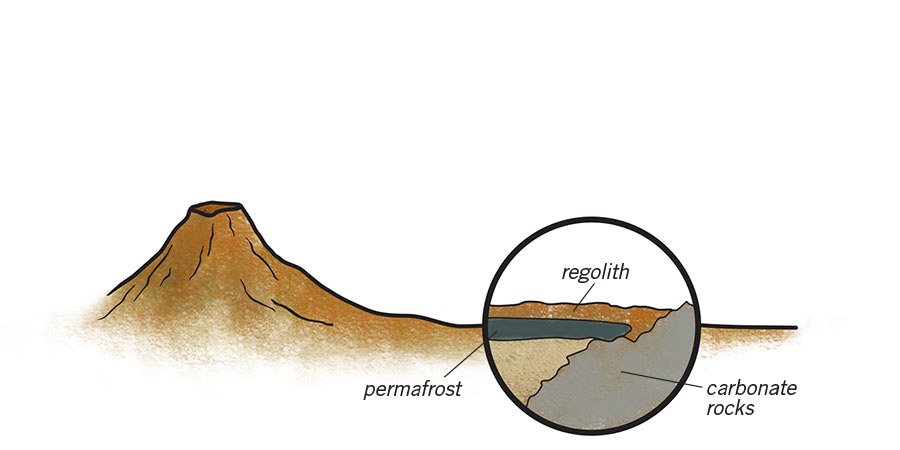Mars—The Other Blue Planet?
As we look at the bitterly cold desert on Mars today, the thought of flowing water seems laughable. Yet evidence is growing that the planet was once wet . . . and this possibility fits nicely in the creation model.
Did water once flow on the surface of another planet in the solar system? Although Mars is now a desert, we have growing evidence that rain and flash floods once scoured the surface, sustaining a network of streams and lakes—and perhaps even an ocean. Today it appears that some of this water is locked up in subsurface permafrost and the rest has escaped into space.
Where did all this liquid water come from, and why did it disappear? These are two of the greatest mysteries in planetary astronomy. Mars is currently too cold and its atmosphere is too thin to support liquid water. So how did it ever produce and sustain an ocean and a thick atmosphere?
The spacecraft and rovers sent to Mars over the past five years are equipped with next-generation instruments to help solve these very questions. Yet despite our ever-increasing knowledge of the Red Planet, investigators are still baffled.
The search is hampered by a glaring flaw in their theories. Since we can’t observe past events, we must make assumptions. If the assumptions are wrong, the conclusions will be wrong. Instead of turning to God’s Word, the one infallible source of truth about planetary history, secular astronomers assume the universe is old. Genesis 1, in contrast, informs us that the Creator formed all the planets on Day Four of Creation Week, just a few thousand years ago. Then the whole cosmos came under God’s judgment because of Adam’s sin (see Genesis 3 and Romans 8:22). Starting with these realities can help astronomers avoid rabbit trails and begin making sense of the evidence.
The Search for Water on Mars
Mars has long fascinated sky gazers because its similarities to Earth held out the possibility that intelligent life once lived there. Despite its small appearance, early telescopes could detect white polar caps and shades that varied seasonally. Some imaginative people thought these varying shades represented growth of vegetation during the Martian spring and summer, when water flowed down from melting snow caps. Some even claimed they saw canals engineered by intelligent life forms!
The Mariner space craft of the 1960s cleared away these fanciful notions about canals, showing moon-like craters scattered across the surface. However, cloudy mists and icy terrain on its polar caps gave space scientists some cause for continued hope that water—essential for life—once flowed on Mars.
Recent missions have confirmed that the southern pole holds large amounts of frozen water under a layer of dry ice (frozen carbon dioxide). If melted, there is enough water to cover the planet in 36 feet (11 m) of liquid. That’s amazing, but it's not enough to fill an ocean.
Despite our ever-increasing knowledge of the Red Planet, investigators are still baffled.
Several missions have probed for evidence of frozen water below the surface. Scientists expected to find subsurface ice near the poles but were surprised when in 2002 Mars Odyssey found signs of ice in soil across the planet, including on the equator. The Mariner Reconnaissance Orbiter (which began orbiting in 2006) detected subsurface ice deposits up to 3,000 feet (1 km) thick, possibly due to past glaciers. It also discovered clean white ice deposits, blown from a fresh meteorite impact in 2008. Clearly, Mars has vast stores of pure water in frozen form. But did this water ever flow in lakes or an ocean?
Evidence of Liquid Water in the Past
The low atmospheric pressure and temperatures on Mars today would seem to eliminate the possibility of flowing water. But water-related effects have often been observed on the planet, such as clouds, frosts, and polar caps. Some of these phenomena arise from frozen CO2 (dry ice). But many of the effects are potentially water-related.
Likewise, while the current atmosphere is extremely cold and not presently conducive to liquid water, several surface features indicate large quantities of water flowed across Mars’ surface in the past. In 1997 the Mars Pathfinder rover noted rounded stones that some geologists believe might have been shaped by tumbling action of water in a stream or flood. Yellow areas on the surface may be deposits left behind by evaporating water. Some sedimentary rocks appear to include smaller fragments of rocks that were once in water.
In 2011 the Mars Reconnaissance Orbiter found strong evidence that liquid water flowed down warmer, low-elevation Martian slopes (actually in gullies). These areas experience higher atmospheric pressure where water could exist briefly in a liquid form. The flows are thought to be due to melting ice from exposed permafrost.1
NASA’s Curiosity rover discovered a stream bed with gravel in 2012. The following year it bored into one of the rocks—the first bore sample ever taken on the planet—and found the rock contained clay minerals that are known only to come from reactions in water.
Many other phenomena point to a once-wet climate on Mars (Figures 1–4). These include channels with drainage patterns like riverbeds on the Earth, alcoves, aprons, alluvial fans, mudflows, and teardrop “islands” from water flows. All of these phenomena are now in dry areas where the water has apparently evaporated or sublimated away (gone directly from ice to vapor).
Perhaps most astonishing is the evidence of ancient shorelines. They ring a deep basin in the north, known as Vastitas Borealis, which is 2.5–3 miles (4–5 km) below the planet’s mean elevation. The chemical properties of the soil below the shorelines indicate that an ocean once filled this area—nearly a third of Mars’ surface.
Remnants of a Watery World?
Volcanos on Mars
For water to remain in liquid form, the planet needed a denser atmosphere and a warmer climate. How could this be possible?
That’s a tough question because we know so little about the layers of Mars and the deep surface. It’s hard enough to interpret the history of Earth correctly, even though it lies just beneath our feet, let alone a planet more than 33.9 million miles (56 million km) away!
Volcanoes may be the key, however. Volcanic emissions on Earth are around 80–90% water vapor. Volcanic eruptions are often followed by torrential rains. Why not on Mars? The early space missions discovered that it has large volcanoes. In fact, Olympus Mons is the largest volcano in the entire solar system. It has a massive 370-mile (600 km) diameter base, and it towers 15 miles (24 km) above the Martian plains. Such massive volcanoes could easily produce a thick, warm atmosphere—and lots of water.
Secular astronomers have a problem because they believe Mars’ lakes and ocean formed before the volcanoes. They’re forced to assume sources like comets somehow produced enough water over millions of years. But how did the water remain, without an atmosphere to hold it?
It’s not a challenge for creationists, who work in a different timeframe. God could easily have created Mars with plenty of water and volcanoes to help sustain a thick atmosphere.
The large Martian volcanoes, which now appear to be dormant, look a lot like shield volcanoes on Earth, which are caused by the alternating emission of lavas and ash. The Hawaiian volcanoes are good examples of this type of volcano. The Hawaiian chain has a total volume of 180,000 cubic miles (750,000 km3) in its 43 volcanoes. But Mars’ volcanic region is even bigger. The five volcanoes on the Tharsis ridge, a “bulge” at the north end of the planet that contains Olympus Mons, account for nearly 4.5 times this volume!
How did these volcanoes get so much bigger than those on Earth? The surface of the Earth is moving on tectonic plates, which broke up during the Flood, so they don’t stay in the same place long enough for magma to build up. As these plates move in treadmill-like motion, new volcanoes pop up in a chain, like the Hawaiian Islands. On Mars, the lack of plate tectonics means the magma continually rises and accumulates in the same place, forming giant mountains like Olympus Mons.
Landing craft and robots found that the surface of Mars has an unusual dichotomy. The Northern Hemisphere has a lower elevation than the southerly part of the globe (as much as 4 miles, or 8 km, below the mean surface elevation!). Did this lopsidedness—including the bulge where Olympus Mons and four other massive volcanoes are located in the north—lead to catastrophic eruptions, spewing enough water to produce an ocean on Mars?
Mars’ Temporary Water Cycle
(Figure 5) Mars is too cold and its atmosphere too thin to support liquid water. But a series of catastrophic volcanic explosions in the past could have changed that, at least temporarily.
What Happened to the Liquid Water?
The diagram shows how volcanoes could have sustained a thick atmosphere and an ocean on Mars, at least for a while until the volcanoes ceased and the atmosphere thinned and cooled.
Volcanoes produce carbon dioxide, water, nitrogen, and sulfur dioxide, which in turn produce atmospheric gases, clouds, rainfall, streams, and lakes. This would give Mars a moderate atmosphere. Thus, Mars would be somewhat like the Earth for a brief time except for the absence of a carbon cycle (which involves plants and animals). Rain would take gases out of the air and cause cooling and more precipitation, thus thinning and cooling the atmosphere on Mars. Repeated precipitation would cause colder and colder temperatures in a process called the “runaway icehouse effect.”
This activity would eventually freeze a layer of water-soaked soil that ultimately became permafrost. The ultraviolet radiation from the sun would break up much of the water into hydrogen and oxygen, and some of the oxygen would escape into space because of the low surface gravity. Both creationists and evolutionists agree that a lot of the oxygen would also have combined with irony surface soils to give Mars the rusty-looking surface we see today.
The result is the surface we see in the present day—a dry, nearly airless Mars. Because the permafrost lies below the surface, when meteorites and asteroids hit, their heat produces mudflows around the craters (Figure 4).
Initial Water on Mars?
Where did the water originally come from? Perhaps the first volcanoes on Mars erupted and spewed out water during Creation Week or at the Fall, without the plate tectonics we find on Earth. This volcanism eventually created the massive, oversized mountains visible on Mars today. Vast eruptions must have extended over large portions of the Martian surface, resulting in a fantastic emission of water vapor and other greenhouse gases into the atmosphere. If the planet did not originally have liquid water and an atmosphere, this ultimately could have terraformed Mars. This rainfall would be followed by the eventual loss of most of the atmosphere, as outlined above.
Because we still have so little information, much more work remains to be done to explain Mars’ topography. Other timelines are possible. Did catastrophe strike at the same time as the watery catastrophe on Earth? (If the Fall impacted the whole cosmos, according to Romans 8:22, perhaps the judgment during Noah’s day extended to other planets.)
It’s fascinating to consider what
our Creator continues to do throughout
our dynamic universe. But in all
of this, we know one thing. Mars was
never populated with intelligent life,
engineers or otherwise. Isaiah 45:18
explains that Earth is the place God
made to be inhabited: “For thus says
the Lord, who created the heavens, who
is God, who formed the earth and made
it, who established it, who did not create
it in vain, who formed it to be
inhabited: I am the Lord, and there is
no other.
” Psalm 115:16 likewise says,
“The heaven, even the heavens, are the
Lord’s; but the earth He has given to
the children of men
.”
Related Videos
What You Aren’t Being Told About Astronomy Excerpt
Answers Magazine
April – June 2015
The eruption of Mount Saint Helens in the 1980s changed how we view catastrophe; on its thirty-fifth anniversary, we examine what we’ve learned since then.
Browse IssueFootnotes
- Other theories have been proposed to explain the gullies and channels, such as wind erosion, liquid carbon dioxide, and liquid methane. We need more observational data to confirm the cause of each landform.
Recommended Resources

Answers in Genesis is an apologetics ministry, dedicated to helping Christians defend their faith and proclaim the good news of Jesus Christ.
- Customer Service 800.778.3390
- Available Monday–Friday | 9 AM–5 PM ET
- © 2025 Answers in Genesis













